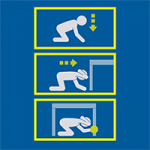ShakeOut information for individuals, households and familiesNgā mōhiohio ShakeOut mā te tangata, ngā whare me ngā whānau
New Zealand ShakeOut is our national earthquake drill and tsunami hīkoi. New Zealand ShakeOut 2024 happened on Thursday 24 October at 9:30am.
Taking part is a great way for you and your whānau to learn the right actions to take before, during and after an earthquake and tsunami.
On this page
Get ready for ShakeOut
Leading up to ShakeOut, here are some things you can do to get ready for an emergency.
- Identify safe places to Drop, Cover and Hold and practise the drill.
- Check to see if you live, work or study in a tsunami evacuation zone. Make plans for a tsunami hīkoi if you are in a coastal area.
- Practise your tsunami hīkoi so you know where to go. Try taking your pets for a walk along your evacuation route.
- Make a Household Emergency Plan so everyone in your household knows what to do in an emergency.
- Work out what supplies you need for a grab bag or an emergency kit.
- Visit the Toka Tū Ake EQC website(external link) to find out how to quake-safe your home.
Sign up for ShakeOut
ShakeOut takes place across the world to remind people of the right action to take during an earthquake. Drop, Cover and Hold. You can also practise a tsunami hīkoi (evacuation) if you're in a coastal area.
Sign up for ShakeOut 2024!
Sign up for shakeout
Doing the drill
ShakeOut is a self-run drill. You can start it in whatever way works for you. You could:
- use a bell, whistle or alarm
- play the New Zealand ShakeOut Announcement over your PA system
- shout “EARTHQUAKE DRILL”, or
- tune in to our Facebook livestream.
Drop, Cover and Hold for 30–60 seconds:
- DROP down on your hands and knees. This protects you from falling but lets you move if you need to.
- COVER your head and neck (or your entire body if possible) under a sturdy table or desk (if it is within a few steps of you). If there is no shelter nearby, cover your head and neck with your arms and hands.
- HOLD on to your shelter (or your position to protect your head and neck) until the shaking stops. If the shaking shifts your shelter around, move with it.
While you are doing the drill, take note of what might be happening around you in a real earthquake. Think about what you might need to do to prepare for a real earthquake.

Use this New Zealand ShakeOut audio announcement to start your earthquake drill. Play it through a speaker or PA so everyone knows the correct action to take.
After the drill
After your drill is complete:
- Talk with whānau about what you learned.
- Make changes to your household emergency plan.
- Share your ShakeOut photos, videos and stories on social media.

Say thanks to kids by giving them our New Zealand ShakeOut 2024 certificate.
pdf | 9.5 MB
Advice for disabled people
If you have a disability or any requirements that may put you at greater risk in an emergency, find advice to get ready.
Find advice for disabled people
Share the ShakeOut
It's important that everyone knows what to do for ShakeOut. You never know where you will be or who's going to be around in an emergency.
- Our Share the ShakeOut page has resources for you to share.
- Share the ShakeOut on social media to let people know about ShakeOut and what your're going to be doing on drill day.
Resources

Make a plan online with your whānau to get through an emergency. Think about the things you need every day and work out what you would do if you didn't have them.

Drop, Cover and Hold is the right action to take in an earthquake. Watch this short video to find out more about Drop Cover and Hold.

If an earthquake is Long or Strong, Get Gone. Watch this short video to find about Long or Strong, Get Gone.

Download and share this factsheet on what to do before, during and after an earthquake.

Tīkina ake, tiria hoki tēnei pukameka mō ngā mahi me whakamahi ā mua, ā roto, ā muri hoki i tētahi rū whenua.
Download and share this factsheet on what to do before, during and after an earthquake.

Download and share this factsheet in English about what to do before, during and after a tsunami.

Tīkina ake, tiria hoki tēnei pukameka mō ngā mahi me whakamahi ā mua, ā roto, ā muri hoki i tētahi ngaru taitoko.
Download and share this factsheet in Te Reo Māori about what to do before, during and after a tsunami.
How to ShakeOut
Find information on ShakeOut for schools, businesses and individuals.
500 participants
Currently registered nationwide


